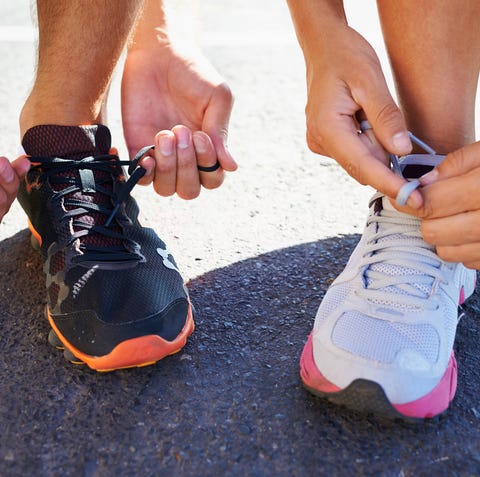
Wondering why your feet swell? Well, running isn’t exactly kind to your feet. It’s simple math: On average, each foot strike exerts a force about two and a half times your body weight. 1600 metres generally consists of around 2,000 to 2,500 steps. No wonder marathoners wind up with the gnarliest blisters and blackest (if not missing) toenails. But what’s up with swollen feet?
When you finally peel off your shoes and your feet and ankles look puffier than normal, it can be alarming. Luckily, “for most runners, swelling is short term and does not typically lead to long-term problems or injury,” says Paul Langer, DPM, a podiatrist in Edina, MN, and expert for Superfeet. The causes range from no big deal to you-might-want-to-talk-to-a-doc.
What Causes Swollen Feet?
For starters, in case you couldn’t tell by the way you were wheezing during 200-metre sprints, your body demands significantly more oxygen during activity than at rest. When you’re running, “blood flow increases to deliver oxygen to the muscles,” explains Langer. As a result, “the volume of the muscles temporarily expands.” This isn’t technically considered swelling, but it does increase the volume of the foot, which can affect shoe fit and performance.
And you know how intense workouts cause microtears in the muscles? Same goes for the valves in the venous system. It’s called venous insufficiency: “The repetitious impact of running causes microtraumas to the small capillaries that deliver oxygen to our extremities, resulting in fluid accumulation and swelling,” says Langer.
Minor post-run swelling—caused by the wear and tear of a long run or intense race—can be soothed by Epsom salt soaks of the feet and legs, says Nelya Lobkova, DPM, a podiatrist based in New York City. And as much as you might not want to move, “minimizing long periods of sitting will help keep the calf muscles active to provide the pump necessary to move the fluid back up the legs and to the heart for recirculation,” says Langer.
Then there’s overuse. “Chronic exertional compartment syndrome may occur when you’re overusing the muscles and tendons,” says Lobkova. In this case, “the tendon sheaths in the feet and legs expand and push up against the nerve and veins in the legs, causing a tourniquet-like effect and causing swelling and sometimes numbness.”
Of course, swelling could be related to a more serious underlying injury. On a localized level, overuse injuries like “ankle sprains, tendinitis, and stress fractures can cause swelling,” says Lobkova. “If there’s an onset of pain with the swelling, it’s advised to stop running, rest, ice, and elevate the feet for at least 24 hours, but if the pain persists, seek medical attention from a foot and ankle specialist.”
It’s not just the impact that’s to blame, though. Your hydration strategy can actually mess with your feet, too. This has to do with the balance of electrolytes and water in your body. “Muscles need sodium to fire properly,” explains Lobkova. “And when the sodium is pulled from our blood to help the muscle contract, water follows.” If the balance of electrolytes to water is off, too much water can enter your cells, causing swollen feet. This is why it’s important to maintain your electrolyte levels, especially on longer runs.
Even your meds could be to blame. “Some medications that may cause swelling or fluid retention in the feet are: calcium-channel blockers used to treat elevated blood pressure, hormone-replacement therapy medications like estrogen and testosterone, NSAIDs taken with diuretics (common blood pressure medication), and some antidepressants,” says Lobkova. If you’re taking meds, talk to your doctor about whether swelling could be a side effect.
Whatever the cause, “swelling that’s accompanied by redness, warmth, and/or pain should never be ignored,” says Langer. “Swelling that persists more than a day or so should be evaluated by a medical professional” to rule out non-running causes that could be related to your kidney, heart, and vascular health.
What Can You Do About Swollen Feet?
While some swelling may be unavoidable, you can still take some preventative measures. Many runners opt to go a half size up in their running shoes to leave some room for swelling during long runs. You can also lace them slightly looser than usual while still maintaining tension around the ankle for support.
Your socks matter, too. “Graduated compression stockings have been shown to decrease swelling due to running,” says Langer. (Marathoners who wore compression socks for 48 hours after a race improved performance by 2.6 percent on a treadmill test two weeks later, a sign that they had recovered faster.) Using compression sleeves like Normatec can also ease swelling and help you recover faster.
Your run starts from your feet, so don’t be afraid to show them a little TLC.